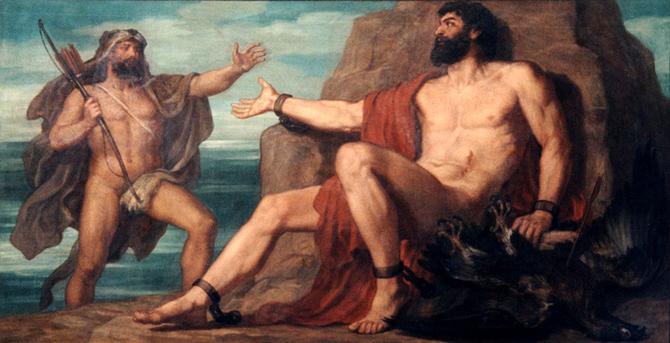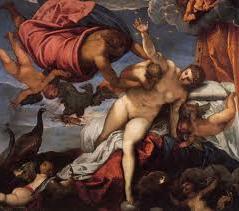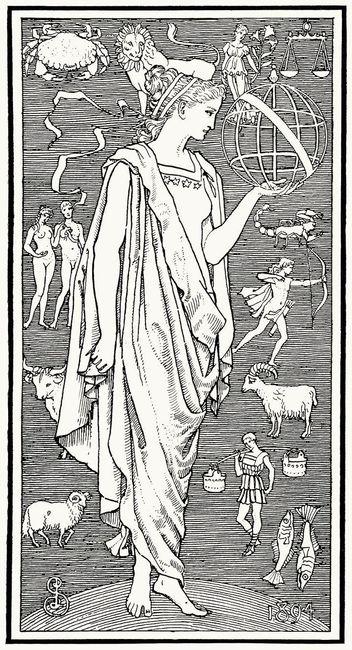Mnemosyne and Muse of Ancient Greece
In European culture it is considered that whenpoet descends inspiration, it means that he was sent down by the muse. Monuments of great poets and composers are often portrayed with a winged muse. But few know that in ancient Greece muse was inspired not only by poets and composers, but even by scientists. In general, the ancient Greeks believed that all wisdom is divine, and is sent down to people from above, gods. Who are they, the muse of Ancient Greece?
The origin of the muses is a favorite theme inAncient Greek and Roman theogony. She devoted a lot of work and even poems (as, for example, "Metamorphoses" Ovid). True, the origin of the muses in the presentation of different authors differ somewhat from each other. Hesiod (VII century BC) in his "Theogony" claims that the ancient Greek muse is the daughter of the king of the Olympic gods of Zeus and the goddess of the memory of Mnemosyne. Taking the form of a shepherd Zeus seduced Mnemosyne, who stayed with him for 9 nights, and as a result gave birth to 9 daughters-muses.
But there are other traditions about how they appeared on thelight muse of ancient Greece. According to Alkman and Mimnerus, they are the daughters of Gaia and Uranus. Thus, they are attributed to uranidam-more ancient gods than kronids (Olympic gods). Other sources attribute to them the descent from the goddess Harmony (which, in turn, falls to the daughter of the goddess of beauty Aphrodite). The very word "muse" means a chant or a poem. All descriptions of the origin of the Muses in one way or another relate to the battle of Zeus with the Titans (uranides) and the establishment of his power - the authority of the Olympic gods. Mnemosyne was to preserve the memory of these his exploits and give it to his descendants. In the ancient Greek city-state of Leybadei there was even a sacred source of Mnemosyne, and everyone who drank from it found knowledge of sources and beginnings.
Images of the goddess of memory Mnemosyns representher usually surrounded by nine daughters. Who are these muse of ancient Greece and patrons (patrons) of what they are? Each of the nine beautiful sisters has its attributes, by which they are easy to recognize. Clio is the patroness of history, portrayed with a style (a stick for writing) and a scroll, in a laurel wreath (as she brought in the annals of history the names of the heroes). Erato with lyre symbolizes lyric poetry, and her sister Euterpe, always depicted with a flute and garlands of flowers, is a lyrical song. Calliope, the muse of knowledge and epic poetry, has the same attributes as Clio. The head of the gloomy Melpomene, the muse of tragedy, is crowned with a wreath of ivy, and in her hands she holds a tragic mask, while Talia is portrayed with a laughing mask, as she patronizes comedies. The dance music of Terpsichore is depicted with a lyre and a plectrum fluttering in the dance. The last two Greek muse are very serious: Urania with the map of the heavenly vault and the compass (the muse of astronomy) and Polyhymnia, the patroness of rhetoric, which holds the royal scepter, as oratory is the dominant one in comparison with others. But more detailed patronage and symbolism of the muses finally formed in the Renaissance.
In the later period of Ancient Greece (II century BC.e.) established the myth of the three muse: Aide (song), Melet (practice) and Mneme (memory). Even later, they began to consider that there are 4 Muses: Telpsikor, Melet, Aod and Arsha. Cicero mentions 7 muses: Neilo, Triton, Heptapora, Asopo, Aheloy, Rhodia and Tipoplo. It was believed that the muse of ancient Greece lived on the holy mountain Helicon, and the god of the sun and the arts Apollo presides over them, because of which the latter received the nickname "Musaget" (the muses driver). Now they are usually portrayed as winged charming creatures, dressed only slightly, arriving to inspire poets to sing love. But in the ancient world they were deities instructing people, giving them knowledge and wisdom, glorifying laws that connect the past and the present.
</ p>>







